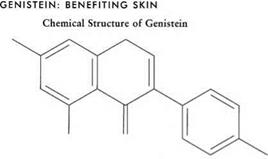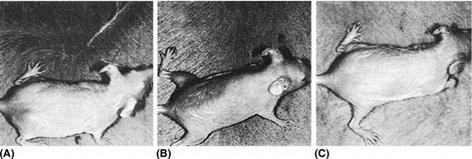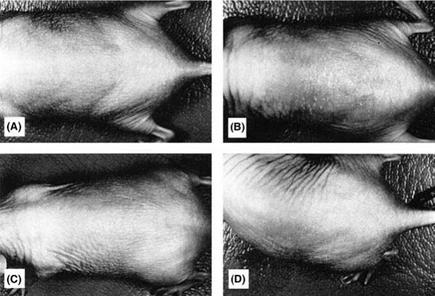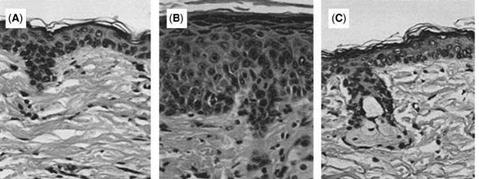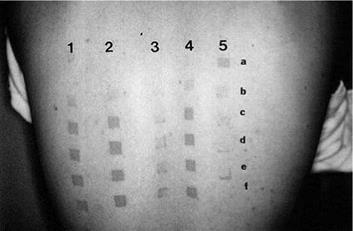The mechanism by which genistein inhibits carcinogenesis may be through inhibition of tyrosine protein kinases, the enzymes which phosphorylate proteins necessary for the regulation of cell division and transformation (132). Of particular importance is phosphorylation of TPK-dependent epidermal growth factor receptors which are related to tumor promotion, including initiation of transcription factors, release of inflammatory mediators (as prostaglandins), and stimulation of cell proliferation (133). Genistein was found to downregulate both UVA – and UVB-induced EGF-R phosphorylation in human epidermoid carcinoma cells in vitro (134,135). In mouse skin, genistein also blocks the UVB-induced expression of the photo-oncogenes c-fos and c-jun which promote cell
|
Figure 7 The molecular structure of genistein. |
proliferation in oncogenesis (136). Similarly, genistein retards UV-induced apoptotic changes—including caspace-3 and p21-activated kinase 2 activation of human epidermal carcinoma cells (137) and phosphokinase C-delta in human keratinocytes (138).
Genistein is also a potent antioxidant. Genistein scavenges peroxyl free radicals, thereby protecting against lipid peroxidation in vitro (139) and in vivo (140). The decreased incidence of cardiovascular disease with high soy diets may be due to genistein’s inhibiting the oxidation of low density lipoprotein (LDL) cholesterol in both aqueous and lipophilic environments. Of direct importance in protection from UV-induced skin damage, genistein has been shown to inhibit in vitro chemical and UV-induced DNA oxidation (141) as well as psoralen plus UVA (PUVA) DNA damage (142,143). The fact that genistein also reduces erythema and histologic inflammation caused by PUVA may have implications for PUVA therapy by reducing possible short – and long-term adverse reactions.
Topical genistein (10 pmol/cm2) protects against acute and chronic UV damage to the skin (134,135). After exposure of Skh:1 hairless mice to UVB, topical genistein blocked acute skin burns and inhibited UVB-induced cutaneous wrinkling, as demonstrated clinically in Figures 8 and 9 (134,135). Histologic analysis confirmed that topical genistein blocks the signs of chronic photodamage—epidermal hyperplasia and reactive acanthosis with nuclear atypia (Fig. 10) (134,135). At a molecular level, UV – induced damage to DNA (as measured by the biomarker 8-hydroxy-2,-deoxyguanosine) was reduced (144). Inhibition of acute UV-induced erythema with topical genistein (5 pmol/cm2) was also demonstrated in humans (134,135): Topical genistein (applied 30 minutes before UVB) inhibited by 1 MED the UVB-induced erythema, as shown in Figure 11. Thus, topical genistein may protect human skin against photodamage.
Equally impressive is the fact that topical genistein also inhibits skin cancer, a consequence of chronic UVB damage. Both the incidence and the multiplicity of UVB – induced skin tumors in Skh:2 hairless mice were reduced by about 90% after 25 weeks of UVB exposure (134,135). Figure 12 shows protection from carcinogenesis of representative mice treated with genistein before UVB exposure. Also, after chemical induction and promotion of skin tumors, topical genistein inhibited tumor cell number by 60-75% (144).
Another possible dermatologic benefit of genistein is as a phytoestrogen. The skin has both alpha and beta nuclear estrogen receptors (145) through which estrogen binding can regulate linked genes of proliferation and differentiation. Genistein has a 30-fold
|
Figure 8 Effect of genistein on UVB-induced acute skin burns in mice were treated topically with 5 pmol genistein 60 minutes before UVB at a dose of 1.8 kJ/cm2 for 10 days. Photographs were taken 24 hours after last UVB irradiation. (A) Negative control (sham irradiation), (B) vehicle before UVB, (C) 5 pmol genistein before UVB. Source: From Ref. 135. |
|
Figure 9 Effect of genistein on UVB-induced chronic photodamage in mice. Skh:1 hairless mice were treated topically with 5 pmol genistein 60 minutes before or five minutes after twice-weekly UVB at a dose of 0.3 kJ/cm2 for four weeks. Photographs were taken 24 hours after last UVB irradiation. (A) Negative control (sham irradiation), (B) vehicle plus UVB, (C) 5 pmol genistein before UVB, (D) 5 pmol genistein after UVB. Source: From Ref. 135. |
higher affinity for ER-beta than ER-alpha (146), but a greater ER-alpha agonist activity than ER-beta (147). Though estradiol has 700-fold more ER-alpha and 45-fold more ER – beta activity than genistein, the possible biologic effect of genistein through dietary soy isoflavones may be important. Oral (148,149) and topical estrogen (150,151) increase the collagen content of skin which diminishes with aging. This effect is especially dramatic in women during and after menopause (152). Genistein may reduce the atrophic appearance
|
Figure 10 Effect of genistein on histological alterations in mice exposed to UVB. Skh:1 hairless mice were treated topically with 5 pmol genistein 60 minutes before UVB at a dose of 0.3 kJ/cm2 twice weekly for four weeks. Mice were killed 24 hours after the last UVB irradiation and skin specimens were taken for histology. (A) Negative control (sham irradiation), (B) vehicle plus UVB, (C) 5 pmol genistein before UVB. Source: From Ref. 135. |
|
Figure 11 Effect of genistein on UVB-induced erythema in human skin. The study was performed in the phototherapy unit in the Department of Dermatology, Mount Sinai Hospital. UVB fluences used a range from 0 to 100 mJ/cm2. Genistein was applied to dorsal skin either 60 minutes before or five minutes after UVB exposure. Photographs were taken 24 hours after UVB irradiation. A minimal erythema dose (MED) for this individual was 40 mJ/cm2. Lane 1: Vehicle before UVB; lane 2: no treatment before or after UVB; lane 3: 1pmol genistein/cm2 of skin before UVB; lane 4: 1pmol genistein/cm2 of skin after UVB; and lane 5: dose response of topical genistein applied before UVB (1 MED) at a dose ranging from 0.05 to 5 pmol/cm2. Source: From Ref. 135. |
of aging skin both by preventing photodamage through inhibition of metalloproteinases in human skin (independent of sunscreen effect) and by stimulating collagen synthesis. Indeed, genistein does increase collagen gene expression in fibroblasts in vitro (153).
Thus, topical genistein shows promise not only in protecting the skin against acute and chronic photodamage but also in enhancing the diminished collagen synthesis of normal intrinsic aging.

